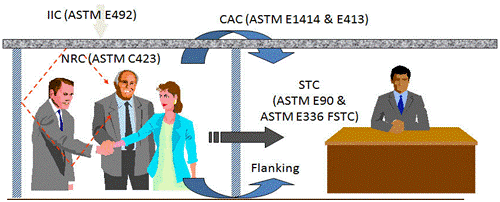Sign In
You're All Set
Welcome back! You are now signed in.
You have been logged out
You have been logged out due to inactivity
Forgot Password
Please enter the email address you used to create the account. We'll send you a link that lets you create a new password.
You're All Set
Please check your email. Click the link in the email to create a new password.
Reset Password
You're All Set
Success! Your password has been updated.
Change Password
You're All Set
Success! Your password has been updated.
ACOUSTICAL SOLUTIONS
Principles

Acoustics affect critical aspects of a building’s function, from productivity in office settings and performance quality in theaters and auditoriums, to the price an apartment, condominium or single-family house can command. Understanding how to select a combination of building materials, system designs and construction technologies that will provide the most appropriate sound control is key to creating a successful acoustical design. (SA200)
Sound Transmission:
Sound is transmitted in a wave motion as an elastic medium produced by a vibrating object. The vibrations move the particles of the medium (such as air) adjacent to it, back and forth, creating an alternate compression and rarefaction of the medium. These disturbances move away from the source in a wave motion, much as a ripple moves along the surface of water when a stone is dropped in. The more elastic a substance, the better it can conduct sound. Lead, for instance, is very inelastic and therefore a poor sound conductor. Steel, on the other hand, is highly elastic, making it an excellent conductor of sound.
Sound travels not only in a straight path from its source but also bounces off partitions, bends around barriers and squeezes through small openings, all of which can allow noise to reach surprisingly far beyond its point of origin. Designers must consider the dynamics of sound when determining how they will control noise within a building.
The basic mechanisms involved in noise control for buildings are sound absorption and sound transmission. Sound absorption is necessary to reduce the reverberation, or echo, in a space to help improve clarity of speech and reduce excessive noise within a room. Sound transmission, either airborne or structural, must be reduced to prevent sound from travelling between two spaces.
Sound Absorption:
• Absorption: An acoustically absorbent material is one where the majority of the incident sound waves are absorbed, rather than reflected back, by the material.
• Reverberation: A highly reverberant space may have a lot of echoes, or reflections off of hard surfaces in the room. Absorptive material can help to reduce the amount of reverberation.
Sound Transmission:
• Airborne sound transmission: Sound traveling through the air and subsequently through partitions and openings.
• Impact sound transmission: Originates by contact with the structure and travels through the structure. Thus, it is governed by a different set of values than airborne sound.

